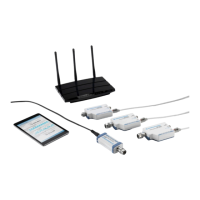Remote control commands
R&S
®
NRPxxS(N)
87User Manual 1177.5079.02 ─ 15
TRIGger:LEVel:UNIT <unit>
Sets the unit of the trigger level if this value is entered without a unit. See also
TRIGger:LEVel on page 86.
Parameters:
<unit> DBM | W | DBUV
*RST: W
Manual operation: See "Trigger Level" on page 53
TRIGger:SENDer:PORT
<sender_port>
Selects the port where the power sensor outputs its own trigger event in case it is trig-
ger sender. See TRIGger:SENDer:STATe for more information.
If the power sensor is the trigger sender, it can output its trigger event either on the
EXTernal<1> or EXTernal2.
If the power sensor triggers itself, the trigger source of the power sensor must be
assigned to the other external port, as shown in the examples.
Parameters:
<sender_port> EXT1 | EXTernal1 | EXT2 | EXTernal2
*RST: EXT1
Example:
TRIG:SEND:PORT EXT1
TRIG:SOUR EXT2
TRIG:SEND:STAT ON
Example:
TRIG:SEND:PORT EXT2
TRIG:SOUR EXT1
TRIG:SEND:STAT ON
TRIGger:SENDer:STATe <state>
Enables or disables the trigger sender mode of the power sensor. In this state, the
power sensor can output a digital trigger signal in sync with its own trigger event.
If enabled, select the output port for the trigger signal using TRIGger:SENDer:PORT.
Typically, the trigger sender uses its internal trigger source. But you can also trigger the
trigger sender externally, because the power sensor has got two external trigger con-
nectors. If you trigger the trigger sender externally, use EXTernal1 as external trigger
input port (trigger source) and EXTernal2 as trigger sender output port or vice versa.
Parameters:
<state> *RST: OFF
TRIGger:SLOPe <slope>
Effective only if TRIGger:SOURce is set to INTernal or EXTernal.
Controlling the measurement

